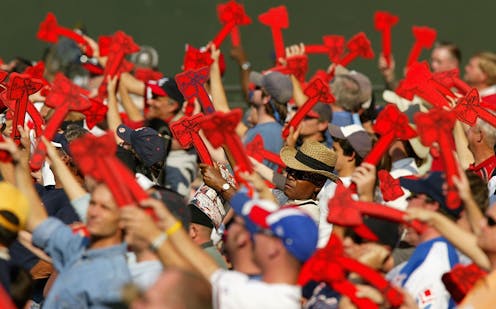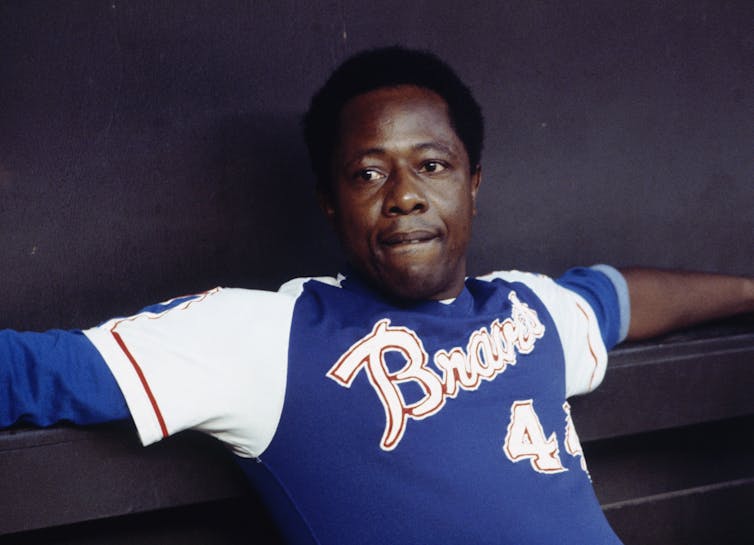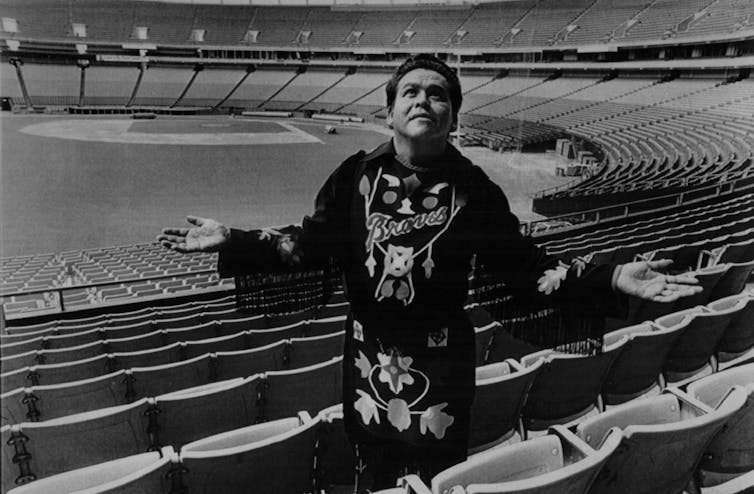The Cleveland Indians changed their team name – what's holding back the Atlanta Braves?
The insistence on preserving the team name – along with fan traditions like the ‘tomahawk chop’ – is even more glaring given the city’s links to the civil rights movement.

In October 1995, as the Cleveland Indians and Atlanta Braves prepared to face off in the World Series, a group of Native Americans rallied outside Atlanta-Fulton County Stadium to protest what they called both teams’ racist names and mascots. Some protesters carried signs, including one that said, “Human beings as mascots is not politically incorrect. It is morally wrong.”
They marched outside the ballpark, where some vendors were selling the foam tomahawks that Braves fans wave during the “tomahawk chop” – a cheer in which they mimic a Native American war chant while making a hammering motion with their arms.
It wasn’t until 2018 that the Indians officially removed their logo, a cartoonish Native American named Chief Wahoo, from their merchandise, banners and ballpark. In 2020 the owners agreed to change the Indians name itself. For the 2022 season, they would begin using the new name, the Guardians.
The Atlanta Braves’ owners, however, have dug in their heels, refusing to replace a name that many Americans – including Native Americans – find offensive and derogatory.
In July 2020 – in the midst of the nationwide protests around racism, sparked by the murder of George Floyd by Minneapolis police – some Atlanta fans again urged the team to change its name. In response, the Braves’ brass sent a letter to season ticket holders, insisting, “We will always be the Atlanta Braves.”
The insistence on preserving the team name – along with fan traditions like the tomahawk chop – is even more glaring given the city’s links to the civil rights movement.
The road to Atlanta
For many years, NFL football team owner Dan Snyder refused to change the name of his Washington Redskins – perhaps one of the more egregiously racist team names in any sport. But in 2020 he finally relented, yielding to pressure from investors and corporate sponsors. The team played as the Washington Football Team for two seasons before becoming the Commanders this year.
However, when professional sports teams do change their names, it’s usually done for marketing reasons rather than social ones.
The NFL’s Tennessee Oilers rebranded themselves the Tennessee Titans in 1999, the Tampa Bay Devil Rays became the Tampa Bay Rays in 2008 and the New Orleans Hornets turned into the Pelicans in 2013.
The Braves have had their own merry-go-round with team names.
The story begins in 1876, when Boston’s professional baseball team was known as the Red Stockings. In 1883, they became the Beaneaters and kept that name until 1907, when new owner George Dovey changed it to the Doves, a tribute to himself. In 1911, William Russell bought the team and renamed it the Rustlers, also after himself. But a year later, James Gaffney, a New York City alderman, purchased the team.
Gaffney was part of Tammany Hall, a New York City political club named after Tamanend, a Delaware Indian chief. Tammany Hall used a Native American wearing a headdress as its emblem and referred to its members as “braves.” So Gaffney gave his team a new moniker. From thenceforth they would be known as the Boston Braves.
In 1935, Bob Quinn purchased the Braves after a season in which they sported the worst record in baseball: 38 wins and 115 losses. Hoping to give the team a fresh start, he renamed it the Boston Bees, but the team continued to perform poorly. In 1940, construction magnate Lou Perini bought the team and changed the name back to the Braves.
In 1953, Perini moved the Braves to Milwaukee – the first team relocation since 1903. Nine years later, he sold the Braves to some Chicago investors led by William Bartholomay, who quickly began looking to move the team to a larger television market.
A commitment to improving race relations
Atlanta Mayor Ivan Allen Jr. courted Bartholomay. To lure the team, he persuaded Fulton County to build Atlanta–Fulton County Stadium for US$18 million – equal to $161 million today.
But Hank Aaron, the Braves’ biggest star, was reluctant to move to Atlanta.
Although it promoted itself as an enlightened place – the city had recently rebranded itself as “The City Too Busy to Hate” – Atlanta was still highly segregated. It was the capital of a state represented by segregationist politicians such as long-serving Sens. Richard Russell and Herman Talmadge. Aaron, a native of Mobile, Alabama, had no interest in returning to the Deep South racism of his birthplace.
The NAACP and Urban League asked Aaron to give the South a second chance. Aaron met with Martin Luther King Jr., who convinced him that bringing the Braves to Atlanta would help the civil rights cause.
Before he would agree to join the Braves in Atlanta, however, Aaron insisted that Fulton County Stadium seating and facilities be desegregated. Mayor Allen shared that view. The city and the Braves complied.

Jimmy Carter, who served as Georgia’s governor from 1971 to 1975 before being elected president, recalled that having a major league team in Atlanta “gave us the opportunity to be known for something that wasn’t going to be a national embarrassment.” Carter said that Aaron “was the first Black man that white fans in the South cheered for.”
The chief and the chop
As the Braves worked to mend relations with the city’s Black community, they didn’t seem to consider how their marketing efforts might offend Native Americans.
In 1966, the year the Braves moved to Atlanta, the team adopted a mascot, Chief Noc-A-Homa, who danced around a teepee behind the left field fence dressed in Native American garb and occasionally performed on the field.

Under public pressure, the team abandoned Chief Noc-A-Homa in 1985. But a few years later, Braves organist Carolyn King started playing the “tomahawk song” before Braves batters stepped up to the plate. By 1991, the fans had fully adopted the chop.
Today, many fans – not to mention many Native Americans – cringe at the music and the chop. To them, it reflects a stereotypical image of Native Americans as violent and uncivilized, similar to those that appeared on TV and in movies for many years.
In 2019, Ryan Helsley, a pitcher for the St. Louis Cardinals and a member of the Cherokee Nation, took issue with the tomahawk chop after pitching against the Braves.
“I think it’s a misrepresentation of the Cherokee people or Native Americans in general. Just depicts them in this kind of caveman-type people way who aren’t intellectual,” Helsley told the St. Louis Post-Dispatch.
“They are a lot more than that,” he said. “It devalues us and how we’re perceived in that way, or used as mascots.”
A name that honors the region’s history
The Braves are now owned by Liberty Media Corp., a $17 billion conglomerate controlled by Chair John C. Malone, who is personally worth $7.5 billion. Only pressure from the Braves’ corporate sponsors, fans, other teams, and even some players will likely push Malone to make a change.
After Aaron died last year, some Braves fans urged the owners to change the name to the “Hammers” to honor the slugger who was nicknamed “Hammerin’ Hank” or just “The Hammer.” His boosters pointed out that it would be simple to put a hammer in place of the tomahawk, which now adorns all Braves uniforms and the team logo. Some version of the cheer could even remain, but with hammers, not tomahawks.
But I’d like to suggest a team name that would make an even bigger statement: the Atlanta Kings, in honor of Martin Luther King Jr. King grew up in Atlanta, attended Morehouse College, and spent most of his adult life there. His childhood home, the church he served as minister and the King Center, an educational nonprofit, are all located in Atlanta.
[Over 150,000 readers rely on The Conversation’s newsletters to understand the world. Sign up today.]
King understood the importance of baseball in American culture. He befriended and worked closely with Jackie Robinson during the civil rights movement. And he helped bring the team to Atlanta.
I think it would be fitting for the Braves to become the Kings and replace the tomahawk with a crown. Or, in the spirit of inclusion, the team could be rechristened as the Atlanta Hammer Kings. And the team could adopt Pete Seeger’s easy-to-sing “If I Had a Hammer” as its theme song.
All it would take is some political courage.
Peter Dreier does not work for, consult, own shares in or receive funding from any company or organization that would benefit from this article, and has disclosed no relevant affiliations beyond their academic appointment.
Read These Next
What’s at stake in Trump’s executive order aiming to curb state-level AI regulation
In the absence of comprehensive federal AI regulation, states have stepped in. The Trump administration,…
The Bible says little about Jesus’ childhood – but that didn’t stop medieval Christians from enjoyin
Legends about Jesus’ early years that circulated in medieval Europe often drew on apocryphal texts.
Sleep problems and depression can be a vicious cycle, especially during pregnancy − here’s why it’s
Inadequate sleep can have negative downstream effects on everyday cognitive functioning and mental health,…





